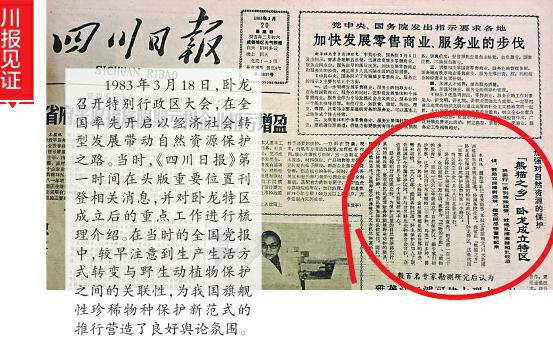Retreat and Advance of "Giant Panda Kingdom" —— Visiting Wolong Special Zone, the first special administrative region in China
Wolong, the giant panda kingdom, is the home of giant pandas. In November, the banks of the Pitiao River crossing the hinterland of Wolong gradually turned red, and millions of acres of mountain forests ushered in the most beautiful season of the year.



For 40 years, in order to protect the giant panda’s home and live a better life, how to get along with nature has been explored in twists and turns.
On March 18th, 1983, the brand of Wolong Special Administrative Region was erected in the jurisdiction of Wolong National Nature Reserve, which was also the first special administrative region in China. Since then, the story of "advance" and "retreat" has been staged every day. What goes forward is rare animals such as giant pandas; What is retreating is the cultivated land, residential areas and other production and living facilities of the aborigines.
Under the background of the construction of the Giant Panda National Park, Wolong has started pilot projects such as total visitor control and behavior guidance, and once again "retreat for progress".
retreat
Aborigines and tourists make way for rare animals and plants
On November 4th, it was Sunday, but there were not many cars and tourists on the 303 provincial road across Wolong.
In mid-October, the Wolong Special Administrative Region issued a "restriction order": tourists must change to the shuttle bus outside the SAR and enter in different periods; Visitors’ activities are also restricted to the vicinity of 11 residential areas in the SAR.
This is because autumn is the migration season of animals, and the influence of human activities should be minimized.
Wolong opened a new paradigm of rare species protection in China more than 30 years ago. Lai Binghui, the 82-year-old first director of Wolong Special Zone, recalled: In 1979, Wolong Nature Reserve was upgraded to a national level, which is a rare forest area directly managed by the Ministry of Forestry in China. The scope of protection expanded from a corner of Yinchanggou to all the two communes of Wolong and Gengda in Wenchuan County, and the area soared from 20,000 hectares to 200,000 hectares. Since then, "not a blade of grass can move" has become an iron law.
The area is large, the protected area is available, and the policy is hard, but it has not achieved strong protection. After more than 30 years, Lai Binghui still remembers that at the end of 1982, 273 households lived in the core area of the reserve, with an annual per capita income of only 112.8 yuan, and nearly 30% did not have enough to eat and wear. In order to get enough to eat, poaching, illegal logging and land reclamation have been repeatedly banned.
Move the residents out of the protected area, which the local authorities cannot afford; Stay in Wolong, but the reserve management agency has no corresponding functions. "Hundreds of households have to eat, see a doctor and study. What should I do?" Lai Binghui, who came to work in Wolong in 1982, was forced to be anxious.
The relevant information was reported to the Ministry of Forestry and the provincial party committee and government. Finally, with the approval of the central government, it was decided to establish a special zone with various functions in the jurisdiction of Wolong Nature Reserve, which was managed by the then Provincial Forestry Department.
The special feature of Wolong Special Administrative Region lies in giving consideration to nature protection and the life and development of aborigines. To achieve this goal, we must completely change the extensive mode of production and realize "returning people to get rich".
At that time, Liu Tiemin, who lived in Yinchanggou, Wolong Town, had just come of age. What he wanted every day was to have a full meal. In the spring of 1983, he handed over his shotgun and axe, and his family could only live on 6 acres of sloping land and the annual afforestation subsidy in 200 yuan. Three years later, as the first batch of ecological immigrants, he moved to Wolongchang Town. In the first year after moving, I bought a TV just by setting up a roadside stall. At noon on November 4, when the reporter met him in Changzhen, Wolong Town, he was greeting guests in his farmhouse. This autumn, his farmhouse turnover has exceeded 50,000 yuan, plus 6 acres of red plum, the annual income is more than 200,000 yuan.
The success of "Liu Tiemin" has inspired more people in Wolong Special Zone. In 1992, all the aborigines in the core area of the reserve moved to the buffer zone along provincial highway 303, set up farmhouses and restaurants, and planted vegetables and red plums. Wolong’s tourism industry has gradually become a climate, receiving hundreds of thousands of tourists every year.
However, the management of the SAR is not optimistic: this is a protected area, and the disorderly influx of tourists brings economic benefits and new problems. "Every year, tourists are good at breaking into the core area." Xia Xuhui, deputy director of Wolong Special Zone, said that it is not only aborigines but also tourists who need to "retreat".
At the beginning of last year, the pilot system of the Giant Panda National Park sent a "policy red envelope": dividing functional areas, controlling the number of visitors, and restricting the activity areas and behaviors. Wolong took the lead in the pilot. "We are calculating how much the maximum number of visitors should be set." Xia Xuhui said.
Past practice shows that there is no conflict between "human retreat" and "people’s wealth". In the past 35 years, Wolong has completed nearly 7000 mu of returning farmland to forests, accounting for more than 75% of the total; By the end of last year, the per capita net income of farmers in the Special Zone had exceeded 14,000 yuan, 20% higher than the provincial average.
enter
The population of giant pandas doubled and their activities expanded.
In the first ten months of this year, Zhang Shujun had met the giant panda on the mountain patrol road four times, and rare animals such as wildebeest and Sichuan golden monkey were more common. In 2016, in Tomb-Sweeping Day, this villager from Dongkou Group of Zhuanlou Village in Wolong Town became one of the first ecological rangers in the province and even the whole country, responsible for the management and protection of 4,000 mu of collective public welfare forest in the village.
Zhang Shujun said that the giant pandas encountered today are either courting, wandering around the territory, or looking at the trees, and even grabbing territory with Sichuan golden monkeys.
Zhang Shujun saw the giant panda for the first time in this area. It was the autumn of 1982. In this newly cultivated sloping farmland, Zhang Shujun, who was "protecting the autumn", found a giant panda in the cornfield. When he saw someone coming, he pulled a few corns and fled. The technician who came to investigate the traces told him that it used to be a bamboo forest, and the giant panda who "stole corn" used it as a feeding place.
A question is in front of us: how to let the giant panda "enter" when people "retreat"? The answer is: repair the habitat and repair the homes of giant pandas.
"This is a technical job." In the spring of the year when the Special Economic Zone was established, Zhang Shujun, 23, did not open up wasteland for the first time, and changed his 6-mu grain ration field into a bamboo forest. Technicians have written bamboo species, plant spacing and row spacing as "guidelines". In that year, he planted cold arrow bamboo and crutch bamboo, which have different flowering and dying cycles, so that giant pandas can eat at different times.
By 1990, more than 300 mu of sloping farmland in the village had become a mixed forest of bamboo, trees and irrigation, and giant pandas no longer had to worry about eating.
The problem of "who will manage" has come out again. Collective forests and land contracts have been implemented, and returning farmland to forests has been started at the turn of the century. In the past, trees grew on barren hills and slopes. In 2016, Wolong Special Zone decided to co-ordinate forest management and protection funds and ecological compensation, select ecological rangers from the surplus labor force, and bring collective forests that cannot be developed by villages into the scope of management and control, so that each forest is managed by special personnel.
Today, nearly 200 people in Wolong have been employed after training, and the management area is about 100,000 mu, which basically eliminates the blind area of forest resources management in the special zone. Zhang Shujun transformed into a forest ranger.
With the "escort" of the rangers, the giant pandas naturally become more and more "presumptuous". Statistics show that the Wolong Special Zone has found more than 200 traces of giant panda activities, almost all over the area except Pitiao Valley. The population number and activity intensity of rare species such as snow leopard, Sichuan golden monkey and wildebeest are the highest on record.
"In the next step, we will continue to carry out the DNA survey of wild giant pandas, not only to expand their activities, but also to achieve a reasonable genetic collocation." Xia Xuhui introduced that since the establishment of the Special Zone 35 years ago, the number of wild giant pandas in Wolong has increased from 75 to 149, nearly doubling; Its activity area has nearly tripled compared with 1983. In the meantime, the SAR has returned 10,000 mu of farmland to forests and grasslands and planted more than 400,000 mu of trees. By the end of last year, the forest coverage rate in the special zone had increased to 63%, and the forest and grass coverage rate had increased to 98%.
Character return visit
The flowering of arrow bamboo brings "big test"
The day of saving giant pandas
Oral speaker: Lai Binghui (First Director and Party Secretary of Wolong Special Administrative Region)
In 1982, I transferred to Wolong and started to prepare for the work of the special zone. In March 1983, after the listing of the SAR, I thought the busyness was over. Unexpectedly, a "big exam" came later.
In the spring of this year, there was a large area of Fargesia in Qionglai Mountain, and Wolong was the main area. Arrow bamboo is the staple food of giant pandas, and it will die when it blooms. At that time, there were only 75 wild giant pandas in Wolong, the lowest on record. Soon, a giant panda was found on the mountain road. After dissection, it was either empty-bellied or undigested dried bamboo. This really makes people cry. During that time, giant pandas who were not in estrus often ran down the mountain to break corn and steal sheep. Hungry like this, what a sin!
As soon as the Wolong Special Zone was established, there was a tough battle to save the giant panda. "above, he searched the Green Void, below, the Yellow Spring, try to find the panda." This sentence is really true. At that time, there were about 300 employees in Wolong Special Zone, and they all had to patrol the mountains to protect the forest to see if there were any hungry pandas. It also mobilized the masses to build many houses in the reserve.
All walks of life have also come to help, including foreign equipment, funds and experts, money orders sent from all over the country, ranging from a few cents to several hundred yuan.
Even with the help of all parties, we were really afraid during that time, for fear that we could not protect the giant panda well; Second, I am afraid to call everywhere: Do you still have veterinarians and cars there? I found another hungry (giant panda).
In 1986, the dead Fargesia gradually germinated, the rations of wild giant pandas gradually recovered, and the phenomenon of starvation and death completely disappeared. On August 12 this year, there was good news from Hetaoping base: the captive giant panda "Blue Sky" was born! This means that we have the genetic code to fight the survival crisis of giant pandas. It made us so happy that we reported good news everywhere by telephone and telegram. This means that the "rescue of giant pandas" operation has achieved a comprehensive victory.
Interview notes
Feelings of the first "Panda Chief Executive"
Lai Binghui is 82 years old and has moved to Beijing for more than 20 years. His memory and hearing have obviously declined. He forgets what he just said, and he doesn’t like being disturbed by outsiders.
On the afternoon of November 2, the reporter dialed his mobile phone, and he immediately accepted the interview invitation, only proposing to change it to the next day. Later, the family said that when the reporter mentioned the "Wolong Special Administrative Region", Lai Binghui’s eyes lit up and he put down the phone and went to rummage through his work notes more than 30 years ago. In order to verify a time and a data, he called Wolong Special Zone many times to inquire-he suggested interviewing the next day in order to be as accurate as possible.
After the interview, he called three times: reporter, I’m sorry, I think there are still some things that have not been made clear. Here’s the thing …
From 1983 to 1990, Lai Binghui served as the director and party secretary of Wolong Special Zone for seven years, so some people called him the first "Panda Chief Executive". "I like this name very much." He said that it is a lifelong honor to witness and participate in opening up a new paradigm for the protection of giant pandas.
After retirement, I have been paying attention to Wolong and the giant panda. The family said that every time he visited the zoo, the old man would look at the giant panda for an hour or two. "Haven’t you seen enough in Wolong?" Lai Binghui replied: "How can I see enough pandas?" (Reporter Wang Chengdong)




















